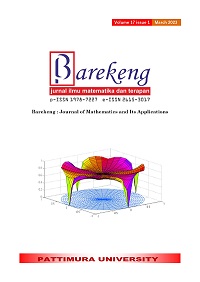SIMULATION OF THE SARIMA MODEL WITH THREE-WAY ANOVA AND ITS APPLICATION IN FORECASTING LARGE CHILLIES PRICES IN FIVE PROVINCES ON JAVA ISLAND
Abstract
Commodities that become potential in the Horticulture Sub-sector are large chilies, so supply and prices must be controlled. One of the efforts that can be made is to predict the price of large chili in the future. However, forecasting is sometimes constrained by several things, such as small sample sizes and outliers. The effect of several factors on the parameter estimation bias can be determined by experimental design by simulating the data obtained from the generation results with several scenarios. The results of the analysis show that all factors have a significant effect on the magnitude of the parameter bias, so that all factors can affect forecasting results. When applying forecasting methods to actual data, paying attention to these three factors is necessary. The application of actual data using the SARIMA method gives good results. It can be seen from the RMSE and MAPE values , which tend to be small. Based on the forecast results for the following 12 periods, it is estimated that the price of big chili in 2022 in five provinces will still fluctuate. The high price of chili in five provinces is predicted to reach its highest in the first three months of 2022. The highest price is predicted to occur in DIY Province in February, which is Rp. 74.230.00/kg. However, from the middle to the end of the year, prices will tend to fall and stabilize. The price will be the lowest in Middle Java Province in December, which is Rp. 20,689.00/Kg.
Downloads
References
BPS, Pola Distribusi Perdagangan Komoditas Cabai Merah Tahun 2019. 2019.
D. C. Montgomery, C. L. Jennings, and M. Kulahci, “Introduction Time Series Analysis and Forecasting,” p. 671, 2015.
L. Hakim, K. Kartomo, and N. Nursalam, “Dynamics of Price Growth of Curly Red Chili and Red Chili in Kolaka District,” Agribus. J., no. December 2020, pp. 19–26, 2020, [Online]. Available: http://www.usnsj.com/index.php/AJ/article/view/1367
K. Duangchaemkarn, W. Boonchieng, P. Wiwatanadate, and V. Chouvatut, “SARIMA Model Forecasting Performance of the COVID-19 Daily Statistics in Thailand during the Omicron Variant Epidemic,” Healthc., vol. 10, no. 7, 2022, doi: 10.3390/healthcare10071310.
N. Deretić, D. Stanimirović, M. Al Awadh, N. Vujanović, and A. Djukić, “SARIMA Modelling Approach for Forecasting of Traffic Accidents,” Sustain., vol. 14, no. 8, 2022, doi: 10.3390/su14084403.
N. P. N. Hendayanti and M. Nurhidayati, “Perbandingan Metode Seasonal Autoregressive Integrated Moving Average (SARIMA) dengan Support Vector Regression (SVR) dalam Memprediksi Jumlah Kunjungan Wisatawan Mancanegara ke Bali,” J. Varian, vol. 3, no. 2, pp. 149–162, 2020, doi: 10.30812/varian.v3i2.668.
R. A. M. Yusuf and T. S. Yanti, “Perbandingan Metode Seasonal Autoregressive Integreted Moving Average (SARIMA) dan Metode Fuzzy Time Series untuk Model Peramalan Jumlah Wisatawan Mancanegara di Bali,” Pros. Stat., pp. 597–605, 2021.
S. H. Sørbye, P. G. Nicolau, and H. Rue, “Model-based bias correction for short AR(1) and AR(2) processes,” no. 1, pp. 1–21, 2020, [Online]. Available: http://arxiv.org/abs/2010.05870
A. S. Ahmar et al., “Modeling Data Containing Outliers using ARIMA Additive Outlier (ARIMA-AO),” J. Phys. Conf. Ser., vol. 954, no. 1, 2018, doi: 10.1088/1742-6596/954/1/012010.
E. B. Ferreira, P. P. Cavalcanti, and D. A. Nogueira, “ExpDes: An R Package for ANOVA and Experimental Designs,” Appl. Math., vol. 05, no. 19, pp. 2952–2958, 2014, doi: 10.4236/am.2014.519280.
G. Brassington, Brassington, and Gary, “Mean absolute error and root mean square error: which is the better metric for assessing model performance?,” Eguga, vol. 19, p. 3574, 2017, [Online]. Available: https://ui.adsabs.harvard.edu/abs/2017EGUGA..19.3574B/abstract
D. C. Montgomery, Design and Analysis of Experiments Eighth Edition. Arizona State University, vol. 2009, no. 2005. 2013.
I. Chang, G. C. Tiao, and C. Chen, “Linked references are available on JSTOR for this article : Time Series Model Specification in the Presence of Outliers,” vol. 81, no. 393, pp. 132–141, 2016.
E. Paparoditis and D. N. Politis, “The asymptotic size and power of the augmented Dickey–Fuller test for a unit root,” Econom. Rev., vol. 37, no. 9, pp. 955–973, 2018, doi: 10.1080/00927872.2016.1178887.
D. Sharma and B. M. G. Kibria, “On some test statistics for testing homogeneity of variances: a comparative study,” J. Stat. Comput. Simul., vol. 83, no. 10, pp. 1944–1963, 2013, doi: 10.1080/00949655.2012.675336.
E. González-Estrada and W. Cosmes, “Shapiro–Wilk test for skew normal distributions based on data transformations,” J. Stat. Comput. Simul., vol. 89, no. 17, pp. 3258–3272, 2019, doi: 10.1080/00949655.2019.1658763.
Copyright (c) 2023 Ratna Nur Mustika Sanusi, Budi Susetyo, Utami Dyah Syafitri

This work is licensed under a Creative Commons Attribution-ShareAlike 4.0 International License.
Authors who publish with this Journal agree to the following terms:
- Author retain copyright and grant the journal right of first publication with the work simultaneously licensed under a creative commons attribution license that allow others to share the work within an acknowledgement of the work’s authorship and initial publication of this journal.
- Authors are able to enter into separate, additional contractual arrangement for the non-exclusive distribution of the journal’s published version of the work (e.g. acknowledgement of its initial publication in this journal).
- Authors are permitted and encouraged to post their work online (e.g. in institutional repositories or on their websites) prior to and during the submission process, as it can lead to productive exchanges, as well as earlier and greater citation of published works.






1.gif)



